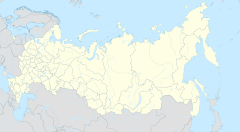User:Digital.Maniac/Tver River Terminal
| Tver River Terminal | |
|---|---|
Тверской речной вокзал | |
 | |
| General information | |
| Status | Partially destroed |
| Architectural style | Stalinist architecture |
| Address | Afanasy Nikitin Embankment, 3 |
| Town or city | Tver |
| Country | Russia |
| Coordinates | 56°51′50″N 35°55′4″E / 56.86389°N 35.91778°E |
| Construction started | 1935 |
| Completed | 1938 |
| Destroyed | August 7th 2017 |
| Design and construction | |
| Architect(s) | Gavrilova, Evgeniya Ivanovna; Rayskiy, P. |
Tver River Terminal or Tverskoy rechnoy vokzal (Russian: Тверской речной вокзал) is a partially destroyed passenger terminal of river transport in Tver. It is situated at the confluence of the Volga and Tvertsa rivers, on the left bank of the Volga, just near the river mouth of Tvertsa. It is included in the registry of the objects of cultural heritage of the Russian Federation's people[1].
The construction began in 1935, near the site of the demolished Otroch Uspensky Monastery, and was completed by 1938. Both architects and most of the workers on site were prisoners[2] of the Volgolag labour camp (part of the Gulag).
Because of the compromises and corner-cutting made during the planning and construction, the building's structure began to decline by the end of 1980s. Due to the financial difficulties that city experienced in 1990s and early 2000s, local authorities were unable to afford proper repairs, which lead to further deterioration.
By that time, following the decline of water transport in the region, the river terminal building was out of the commission for almost a decade. In the following years, up until 2011, it was sometimes used as a venue for art expositions, while some of the sections were rented out to various tenants.
On the eve of August 7th 2017, main building began collapsing[3] -- a process that continued on the next day, eventually leading to the loss of external walls, floor structures and the roof[4].
Events after the collapse
[edit]Immediately after the event, the governor of the Tver Oblast, Igor Rudenya announced that terminal's building will be restored in its historical form[5]. However, no firm dates were announced with the regard to that statement.
On August 28th of 2017 one of the regional media outlets has reported that local authorities knew about building was about to collapse for at least few months, as they've ordered an inspection on building's constructions[6], but ultimately decided to hold off with emergency repairs because of their cost.

By November of 2017 most of the rubble from the collapse was cleared, and any unstable leftovers were forced down. The building itself was covered with decorative banner and fenced off the pier and pedestrian walkways[7], in order to protect the people from any random falling debris.
In April of 2018 Aleksandra Smirnova, deputy head of Tver's regional chapter of the All-Russian Society for the Protection of Monuments of History and Culture has stated in the interview[8] that budget of the Tver Oblast for 2018 has no money allocated for the emergency repairs or the reconstruction of the terminal.
On June 19th of 2019 the chairman of Tver Duma (lower house of the regional parliament) Evgeny Pichuyev, answering to the question about river terminal's fate, has stated that city has no funds for the restoration, and that it's necessary to find an investor who will be interested in funding the repairs.[9].
On July 22nd of 2019 local authorities have announced[10] that a complex engineering study will be undertaken in order to develop suggestions and instructions on the restoration procedure. However, it was also stated that no hard decision on the building's fate will be made until the study is complete: should the engineers decide that there's an irreparable damage, the building most likely will be demolished rather than restored. The results of the study are planned to be announced by the end of December 2019.
External links
[edit]- Post-collapse video, depicting the state of the terminal
- Historic photos of the building and its site
56°51′50″N 35°55′4″E / 56.86389°N 35.91778°E
Category:Transport infrastructure completed in 1938 Category:Stalinist architecture Category:Ports and harbours of Russia Category:Water transport in Russia
- ^ "Order of the Legislative assembly of the Tver region #647, Nov 27th 1997" (in Russian). Legislative assembly of the Tver region. Retrieved 2019-07-30.
- ^ "Tver river terminal (1935-1938)" (in Russian). Tversvod: public monitoring of the architectural and historical landmarks. Retrieved 2019-07-30.
- ^ "Tver's river terminal building partially collapsed" (in Russian). RBC. Retrieved 2019-07-30.
- ^ "Sad news, a sad realization, and an important lesson". Russia Through The Lens. Retrieved 2019-07-30.
- ^ "Igor Rudenya: River terminal will be restored in its historical form" (in Russian). Government of the Tver Oblast. Retrieved 2019-07-30.
- ^ "Experts have pointed towards an exact place where Tver River Terminal four months before it did, but nobody listened to them" (in Russian). Tverigrad.ru. Retrieved 2019-07-30.
- ^ "Collapsed building of Tver River Terminal has been covered with decorative banner" (in Russian). Tverigrad.ru. Retrieved 2019-07-30.
- ^ "Mode: "self-destruction". Aleksandra Smirnova explains why landmarks in Tver continue to deteriorate" (in Russian). Karavan. Retrieved 2019-07-30.
- ^ "Yards, playgrounds, river terminal and storm drains: deputies have answered to voters questions" (in Russian). Tver Information Agency. Retrieved 2019-07-30.
- ^ "The fate of the Tver's River Terminal collapsed building will be decided after an engineering study" (in Russian). Tverigrad.ru. Retrieved 2019-07-30.

